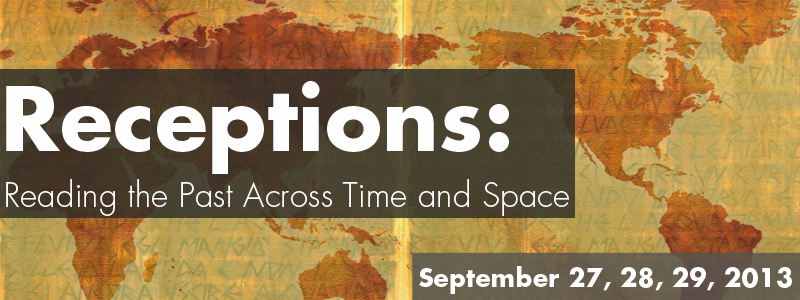A Look Back at the 2013 Receptions Conference
July 21, 2014
The 2013 receptions conference has come to a close, but hopefully many of the conversations prompted by its papers and presentations will continue in the various fields of research brought together in September. Personally, I know that many of the talks asked me to reconsider some of my more casual assumptions about classical canons, spheres of influence, and the many forms of an “afterlife” a single text can take.
Many presenters offered the perspective that reception is a performative act. Of course, texts can be adapted onto stages as in the case of Hans Henny Jahn’s Medea or The Silk Road Company’s Gilgamesh. Then in other cases, we were told about narratives that are disseminated in performing mediums that extend beyond a Western theater auditorium; the Rāmāyaṇa has been explicated through a combination of lecture and dance and biblical verses once found new relevance in political puppet shows. Through these examples, I began to think of reception as an active process- informed by multiple collaborators and always availing itself of the potential for reinterpretation.
Early in the conference proceedings, Arturo Arias offered the observation that in the Guatemalan creation myth Popul Wuj there is no true separation between object and subjects; by extension, nature does not exist in the form of fragmented objects. Some panels expanded on a similar understanding of the cosmos by drawing our attention to the nonhumans who populate these narratives: the owls who were once Penelope’s maids in the Penelopiad, the dog-headed natives found in Chinese maps, and even the winds and rivers belonging to the California landscape. In a memorable example of the nonhuman’s entrance into our discussion, Wai Chee Dimock used the image of the maggot in Gilgamesh to probe what the epic has to say about humanity. Ralph Hexter was among the speakers who elaborated on that same thread of thought, wondering how epics preserve our history, set terms for our goals in life, and determine the boundaries between here and there, us and them.
A number of presenters discussed another category of the nonhuman – the physical objects we occasionally look past to see through to the reception “itself.” Our discussions at times reminded us of the physicality and the texture of art and literature – from photographs, facsimiles, and maps to the aura around museum objects.
As Wai Chee Dimock told us during the Keynote address, decomposing texts are the lifeblood that generate new ones: a fitting motto for a conference so focused on the active process of reception and the gritty forces responsible for keeping the cycle turning. The 2013 receptions conference has asked us to “recycle” our research and I hope to share some of the new ideas precipitated by our discussion as they construct themselves anew in the months and years ahead.


